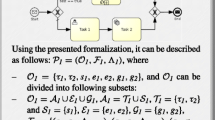Abstract
An organisation’s activity under dynamic changes of business processes requires continuous improvement of business practices. This implies the necessity of refining decision making processes. Business rules [6], [8] enable experts to transfer enterprise strategy onto the operational level using simple sentences which, in turn, can automate reactions to subsequent events both inside and outside an organisation. The main advantage of the business rules is their simplicity and flexibility so they can be easily utilised by different organisations for different purposes. In order to represent knowledge in a pseudo-natural language understandable to information systems (business rules engines), notation and description standards are required. This study presents an overview of the most popular business rules description languages and proposes criteria for their classification. Based on those criteria a comprehensive classification of business rules modelling languages are provided.
Access this chapter
Tax calculation will be finalised at checkout
Purchases are for personal use only
Preview
Unable to display preview. Download preview PDF.
Similar content being viewed by others
References
Antoniou, G., Damasio, C., Grosof, B., Horrocks, I., Kifer, M., Maluszynski, J., Patel-Schneider, P.: Combining Rules and Ontologies - A Survey. Deliverables I3-D3, REWERSE (March 2005), http://rewerse.net/deliverables/m12/i3-d3.pdf
Boley, H.: Are Your Rules Online? Four Web Rule Essentials. In: Paschke, A., Biletskiy, Y. (eds.) RuleML 2007. LNCS, vol. 4824, pp. 7–24. Springer, Heidelberg (2007)
Bry, F., Marchiori, M.: Ten Theses on Logic Languages for the Semantic Web. In: Fages, F., Soliman, S. (eds.) PPSWR 2005. LNCS, vol. 3703, pp. 42–49. Springer, Heidelberg (2005)
Gottesdiener, E.: Business RULES show power, Promise. Issue of Application Development Trends 4(3) (1997)
Graham, I.: Business Rules Management And Service Oriented Architecture: A Pattern Language. Wiley (2007)
Halpin, T.: Business Rules and Object Role Modeling. Issue of Database Programming & Design 9(10), 66–72 (1996)
Heflin, J., Hendler, J., Luke, S.: SHOE: A Knowledge Representation Language for Internet Applications. Technical Report CS-TR-4078, UMIACS TR-99-71 (1999)
Morgan, T.: Business Rules and Information Systems. Addison-Wesley Publishing, Boston (2002)
Paschke, A.: Rule-Based Service Level Agreements - Knowledge Representation for Automated e-Contract, SLA and Policy Management. IDEA Verlag GmbH, München (2006)
Ross, R.: Principles of the Business Rule Approach. Addison-Wesley Information Technology Series (2003)
The Business Rules Group. Defining Business Rules, What are they really? (July 2001), http://www.businessrulesgroup.org
Wagner, G., Damasio, C., Antoniou, G.: Towards a general web rule language. International Journal of Web Engineering and Technology Archive 2, 181–206 (2005)
Author information
Authors and Affiliations
Corresponding author
Editor information
Editors and Affiliations
Rights and permissions
Copyright information
© 2014 Springer International Publishing Switzerland
About this chapter
Cite this chapter
Gaweł, B., Skalna, I. (2014). Model Driven Architecture and Classification of Business Rules Modelling Languages. In: Mach-Król, M., Pełech-Pilichowski, T. (eds) Advances in Business ICT. Advances in Intelligent Systems and Computing, vol 257. Springer, Cham. https://doi.org/10.1007/978-3-319-03677-9_8
Download citation
DOI: https://doi.org/10.1007/978-3-319-03677-9_8
Publisher Name: Springer, Cham
Print ISBN: 978-3-319-03676-2
Online ISBN: 978-3-319-03677-9
eBook Packages: EngineeringEngineering (R0)




